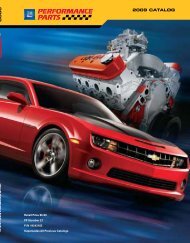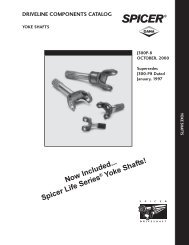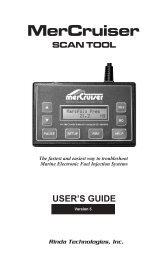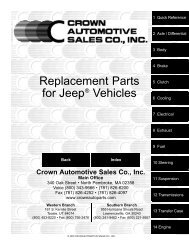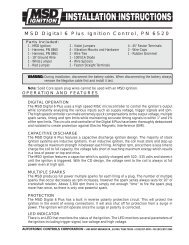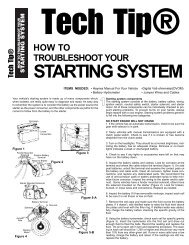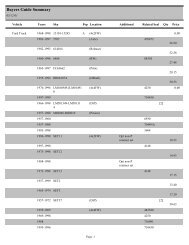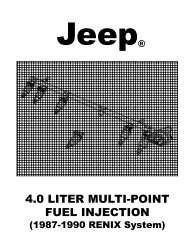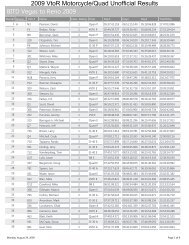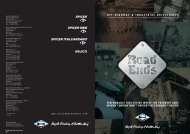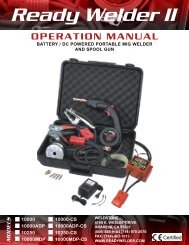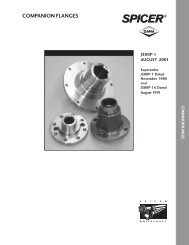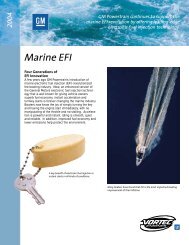Ball and Roller Bearings - Ntn-snr.com
Ball and Roller Bearings - Ntn-snr.com
Ball and Roller Bearings - Ntn-snr.com
You also want an ePaper? Increase the reach of your titles
YUMPU automatically turns print PDFs into web optimized ePapers that Google loves.
Lubrication<br />
(1) Base oil<br />
Natural mineral oil or synthetic oils such as diester oil,<br />
silicone oil <strong>and</strong> fluorocarbon oil are used as grease base<br />
oils.<br />
Table 11.4 Consistency of grease<br />
NLGI<br />
Consistency<br />
No.<br />
JIS (ASTM)<br />
Worked<br />
penetration<br />
Applications<br />
Mainly, the properties of any grease is determined by<br />
the properties of the base oil. Generally, greases with a<br />
low viscosity base oil are best suited for low temperatures<br />
<strong>and</strong> high speeds; while greases made from high viscosity<br />
base oils are best suited for heavy loads.<br />
(2) Thickening agents<br />
Thickening agents are <strong>com</strong>pounded with base oils to<br />
maintain the semi-solid state of the grease. Thickening<br />
agents consist of two types of bases, metallic soaps <strong>and</strong><br />
non-soaps. Metallic soap thickeners include: lithium,<br />
sodium, calcium, etc.<br />
Non-soap base thickeners are divided into two groups;<br />
inorganic (silica gel, bentonite, etc.) <strong>and</strong> organic (polyurea,<br />
fluorocarbon, etc.).<br />
The various special characteristics of a grease, such as<br />
limiting temperature range, mechanical stability, water<br />
resistance, etc. depend largely on the type of thickening<br />
agent used. For example, a sodium based grease is<br />
generally poor in water resistance properties, while<br />
greases with bentone, poly-urea <strong>and</strong> other non-metallic<br />
soaps as the thickening agent are generally superior in<br />
high temperature properties.<br />
(3) Additives<br />
Various additives are added to greases to improve<br />
various properties <strong>and</strong> efficiency. For example, there are<br />
anti-oxidents, high-pressure additives (EP additives), rust<br />
preventives, <strong>and</strong> anti-corrosives.<br />
For bearings subject to heavy loads <strong>and</strong>/or shock loads,<br />
a grease containing high-pressure additives should be<br />
used. For <strong>com</strong>paratively high operating temperatures or<br />
in applications where the grease cannot be replenished<br />
for long periods, a grease with an oxidation stabilizer is<br />
best to use.<br />
(4) Consistency<br />
The consistency of a grease, i.e. the stiffness <strong>and</strong><br />
liquidity, is expressed by a numerical index.<br />
The NLGI values for this index indicate the relative<br />
softness of the grease; the larger the number, the stiffer<br />
the grease. The consistency of a grease is determined<br />
by the amount of thickening agent used <strong>and</strong> the viscosity<br />
of the base oil. For the lubrication of rolling bearings,<br />
greases with the NLGI consistency numbers of 1, 2, <strong>and</strong><br />
3 are used.<br />
General relationships between consistency <strong>and</strong><br />
application of grease are shown in Table 11.4.<br />
0<br />
1<br />
2<br />
3<br />
4<br />
355385<br />
310340<br />
265295<br />
220250<br />
For centralized greasing use<br />
For centralized greasing use<br />
For general use <strong>and</strong> sealed bearing use<br />
For general <strong>and</strong> high temperature use<br />
175205 For special use<br />
(5) Mixing of greases<br />
When greases of different kinds are mixed together, the<br />
consistency of the greases will change (usually softer), the<br />
operating temperature range will be lowered, <strong>and</strong> other<br />
changes in characteristics will occur. As a general rule,<br />
greases with different bases oil, <strong>and</strong> greases with different<br />
thickener agents should never be mixed.<br />
Also, greases of different br<strong>and</strong>s should not be mixed<br />
because of the different additives they contain.<br />
However, if different greases must be mixed, at least<br />
greases with the same base oil <strong>and</strong> thickening agent<br />
should be selected. But even when greases of the same<br />
base oil <strong>and</strong> thickening agent are mixed, the quality of the<br />
grease may still change due to the difference in additives.<br />
For this reason, changes in consistency <strong>and</strong> other qualities<br />
should be checked before being applied.<br />
11.3.2 Amount of grease<br />
The amount of grease used in any given situation will<br />
depend on many factors relating to the size <strong>and</strong> shape of<br />
the housing, space limitations, bearing's rotating speed<br />
<strong>and</strong> type of grease used.<br />
As a general rule, housings <strong>and</strong> bearings should be<br />
only filled from 30% to 60% of their capacities.<br />
Where speeds are high <strong>and</strong> temperature rises need to<br />
be kept to a minimum, a reduced amount of grease<br />
should be used. Excessive amount of grease cause<br />
temperature rise which in turn causes the grease to<br />
soften <strong>and</strong> may allow leakage. With excessive grease fills<br />
oxidation <strong>and</strong> deterioration may cause lubricating<br />
efficiency to be lowered.<br />
Moreover, the st<strong>and</strong>ard bearing space can be found by<br />
formula (11.1)<br />
VKW (11.1)<br />
where,<br />
V : Quantity of bearing space open type (approx.) cm 3<br />
K : Bearing space factor (Table 11.5)<br />
W: Mass of bearing kg<br />
A-72



